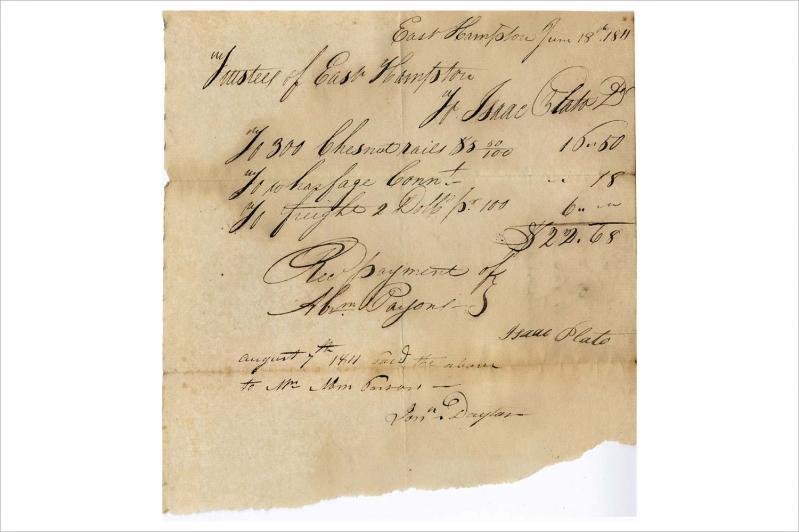This invoice from Isaac Plato (circa 1767-1832) is signed by both Plato and Abraham Parsons, who paid him on behalf of the East Hampton Town Trustees. The invoice is for “chestnut rails” for the East Hampton parsonage and a trip to Connecticut, presumably for supplies or materials.
Additional accounts suggest that Isaac Plato was a skilled woodworker or carpenter; in April 1804 he received the mill shaft for the Gardiner Mill, which Nathaniel Dominy V built.
The Presbyterian Church was East Hampton’s first religious establishment, and during the early years it remained deeply intertwined with local government. Isaac Plato’s invoice is dated June 11, 1811, just over a month after the installation of the newly arrived Rev. Ebenezer Phillips on May 5 of that year. The parsonage probably needed some renovations or repairs for Phillips, who lived at the Mulford Farm during his tenure as pastor.
Isaac Plato was a prominent free-born African-American who appears in tax rolls, legal documents, and John Lyon Gardiner’s account books. The 1801 East Hampton tax rolls indicate that Plato owned no taxable real estate, but had $110 of personal property. By 1804, he clearly owned land in Springs, since his property is described in the metes and bounds of a deed. It was valued at $200 in the 1811 tax rolls, double what it was worth 10 years earlier.
In 1807, he and Martin Plato were listed among the shareholders for the new Springs School building.
According to a Ph.D. dissertation by Allison McGovern, an anthropological archaeologist, Isaac and his wife, Huldah, raised five children: Isaac Jr., Charles R., Alfred, Silas, and Harriet. Their sons Isaac Jr. and Silas became whalers. Isaac Jr. appears to have been identified at times as Captain Plato. Charles Plato went on to help found St. David’s A.M.E. Zion Church in the Eastville section of Sag Harbor.
Andrea Meyer, a librarian and archivist, is head of collection for the East Hampton Library’s Long Island Collection.




